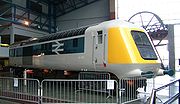.gif)
British Rail Class 41 (HST)
Encyclopedia


British Rail
British Railways , which from 1965 traded as British Rail, was the operator of most of the rail transport in Great Britain between 1948 and 1997. It was formed from the nationalisation of the "Big Four" British railway companies and lasted until the gradual privatisation of British Rail, in stages...
Class 41 was the original classification for the power cars of the prototype High Speed Train
High Speed Train
There are three types of trains in Britain that have been traditionally viewed as high speed trains:* Advanced Passenger Train - Tilting trains which never entered into regular revenue-earning service....
. However, the train was later re-classified as a diesel-electric multiple unit, and the whole set became Class 252
British Rail Class 252
Class 252 was the classification allocated to the prototype High Speed Train unit, numbered 252001.-History:When originally built, in 1972, the prototype High Speed Train units were considered to be formed of two locomotives at either end of a rake of carriages...
. They were of Bo-Bo
UIC classification
The UIC classification of locomotive axle arrangements describes the wheel arrangement of locomotives, multiple units and trams. It is set out in the International Union of Railways "Leaflet 650 - Standard designation of axle arrangement on locomotives and multiple-unit sets". It is used in much...
wheel arrangement
Wheel arrangement
In rail transport, a wheel arrangement is a system of classifying the way in which wheels are distributed beneath a locomotive.. Several notations exist to describe the wheel assemblies of a locomotive by type, position, and connections, with the adopted notations varying by country...
.
Two power cars were built, 41001 and 41002. After the Class 252 re-classification these were renumbered into the carriage numbering range
British carriage and wagon numbering and classification
A number of different numbering and classification schemes have been used for carriages and wagons on Britain's railways, and this page explains the principal systems...
as 43000 and 43001.
Today, 41001 is preserved in the National Railway Museum
National Railway Museum
The National Railway Museum is a museum in York forming part of the British National Museum of Science and Industry and telling the story of rail transport in Britain and its impact on society. It has won many awards, including the European Museum of the Year Award in 2001...
in York
York
York is a walled city, situated at the confluence of the Rivers Ouse and Foss in North Yorkshire, England. The city has a rich heritage and has provided the backdrop to major political events throughout much of its two millennia of existence...
, while 41002 was scrapped at CF Booth, Rotherham, in December 1990. Both were allocated to Headquarters (HQ).
Plans were announced in May 2011 to return 41001 to service by the 125 group, who will be taking the power car on long term loan to complete the work required.

